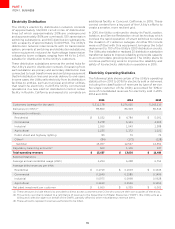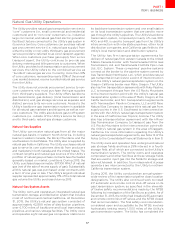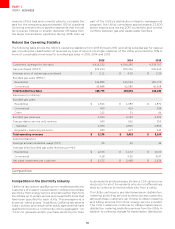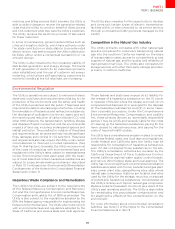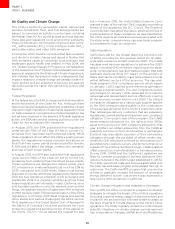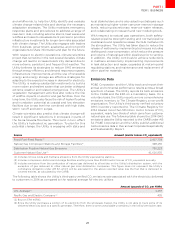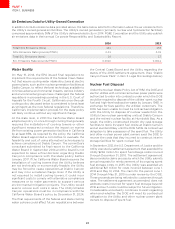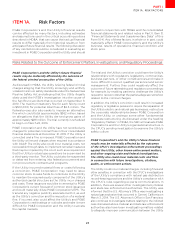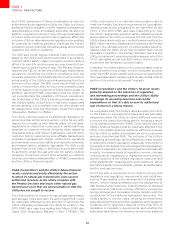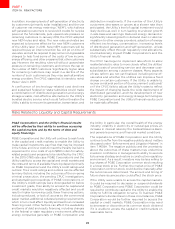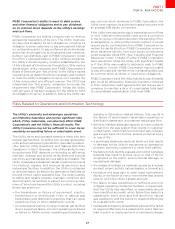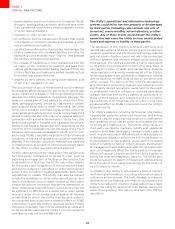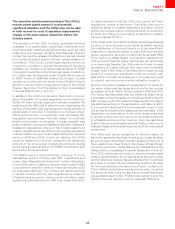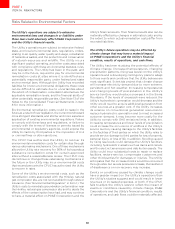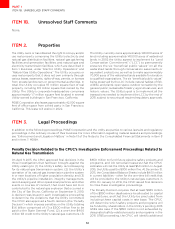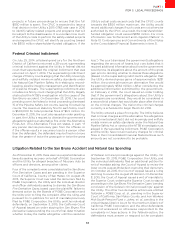PG&E 2015 Annual Report Download - page 31
Download and view the complete annual report
Please find page 31 of the 2015 PG&E annual report below. You can navigate through the pages in the report by either clicking on the pages listed below, or by using the keyword search tool below to find specific information within the annual report.
23
PART I
ITEM 1A.RISK FACTORS
ITEM 1A. Risk Factors
PG&E Corporation’s and the Utility’s financial results
can be aected by many factors, including estimates
and assumptions used in the critical accounting policies
described in MD&A, that can cause their actual financial
results to dier materially from historical results or from
anticipated future financial results. The following discussion
of key risk factors should be considered in evaluating an
investment in PG&E Corporation and the Utility and should
be read in conjunction with MD&A and the consolidated
financial statements and related notes in Part II, Item 8,
“Financial Statements and Supplementary Data” of this
Form 10-K. Any of these factors, in whole or in part, could
materially aect PG&E Corporation’s and the Utility’s
business, results of operations, financial condition, and
stock price.
Risks Related to the Outcome of Enforcement Matters, Investigations, and Regulatory Proceedings
PG&E Corporation’s and the Utility’s future financial
results may be materially aected by the outcome of
the federal criminal prosecution of the Utility.
As discussed in MD&A, the Utility is facing federal criminal
charges alleging that the Utility knowingly and willfully
violated minimum safety standards under the Natural Gas
Pipeline Safety Act and alleging that the Utility illegally
obstructed the NTSB’s investigation into the cause of
the San Bruno accident that occurred on September 9,
2010. The maximum statutory fine for each felony count
is $500,000, for potential total fines of $6.5 million. The
federal prosecutor also seeks to impose an alternative
fine which could total approximately $562 million, based
on allegations that the Utility derived gross gains of
approximately $281 million. The trial currently is scheduled
to begin on March 22, 2016.
PG&E Corporation and the Utility have not recorded any
charges for potential criminal fines in their consolidated
financial statements at December 31, 2015. If the Utility is
convicted and a fine is imposed, PG&E Corporation and
the Utility will record charges when required in accordance
with GAAP. The Utility also could incur material costs, not
recoverable through rates, to implement remedial measures
that may be imposed by the court, such as a requirement
that the Utility’s natural gas operations be supervised by
a third-party monitor. The Utility could also be suspended
or debarred from entering into federal procurement and
non-procurement contracts and programs.
If the Utility incurred material fines or costs following
a conviction, PG&E Corporation may need to issue
common stock to raise funds to contribute to the Utility
to maintain the required equity component of the Utility’s
authorized capital structure as the Utility incur charges
and costs. These issuances would be incremental to PG&E
Corporation’s current forecast of common stock issuances
and could materially dilute PG&E Corporation’s EPS. The
trial and any negative publicity associated with it, as well
as the Utility’s conviction and the imposition of a material
fine, if incurred, also could aect the Utility’s and PG&E
Corporation’s credit ratings or outlooks and make it more
dicult for PG&E Corporation and the Utility to access
the capital markets.
The trial and the Utility’s conviction could harm the Utility’s
relationships with regulators, legislators, communities,
business partners, or other constituencies and make it
more dicult to recruit qualified personnel and senior
management. Further, they could negatively aect the
outcome of future ratemaking and regulatory proceedings;
for example, by enabling parties to challenge the Utility’s
request to recover costs that the parties allege are somehow
related to the criminal charges.
In addition, the Utility’s conviction could result in increased
regulatory or legislative pressure to require the separation of
the Utility’s electric and natural gas businesses, restructure
the corporate relationship between PG&E Corporation
and the Utility, or undergo some other fundamental
corporate restructuring. As discussed under the heading
“Regulatory Matters” in MD&A, the SED will evaluate PG&E
Corporation’s and the Utility’s organizational structure in
the CPUC’s pending investigation to examine the Utility’s
safety culture.
PG&E Corporation’s and the Utility’s future financial
results may be materially aected by the outcomes
of the CPUC’s investigative enforcement proceedings
against the Utility, other known enforcement matters,
and other ongoing state and federal investigations.
The Utility also could incur material costs and fines
in connection with future investigations, citations,
audits, or enforcement actions.
The Utility could incur material charges, including fines and
other penalties, in connection with the CPUC’s investigations
of the Utility’s compliance with natural gas distribution
record-keeping practices and the Utility’s compliance with
the CPUC’s rules regarding ex parte communications. In
addition, there are several other investigations by federal
and state law enforcement authorities. The Utility was
informed that the U.S. Attorney’s Oce was investigating a
natural gas explosion that occurred in Carmel, California on
March 3, 2014. The U.S. Attorney’s Oce in San Francisco
also continues to investigate matters relating to the indicted
case discussed above. Federal and state law enforcement
authorities also have been investigating matters related
to allegedly improper communication between the Utility





